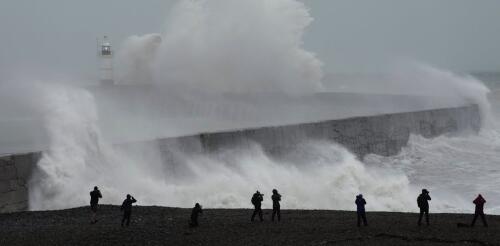environment
Cranberries are a staple in U.S. households at Thanksgiving – but how did this bog dweller end up on holiday tables? Compared to many valuable plant species that were domesticated over thousands of years, cultivated cranberry (Vaccinium macrocarpon) is a young agricultural crop, just as the U.S. is a young country and Thanksgiving is a relatively new holiday. But as a plant scientist, I’ve learned much about cranberries’ ancestry from their botany and genomics. New on the plant breeding scene Humans have cultivated sorghum for some 5,500 years, corn for around 8,700 years and cotton for about 5,000 years. In contrast, cranberries were domesticated around 200 years ago – but people were eating the berries before that. Wild cranberries are native to North America. They were an important food source for Native Americans, who used them in puddings, sauces, breads and a high-protein portable food called pemmican – a carnivore’s version of an ene...
The annual United Nations Climate Change Conference, better known as COP, that starts Nov. 30 in the United Arab Emirates will bring together governments, businesses, international organizations and NGOs to shine a spotlight on the climate emergency the world faces and consider solutions to the crisis. The alarming rates at which we are losing species is not just a tragedy of epic proportions – the destruction of biodiversity also robs humanity of one of its strongest defenses against climate change. Retaining the earth’s diverse mix of animals and plants is crucial for the planet’s future, yet any plan to halt its loss must grapple with the reality that not every species can be saved from extinction because of the limited resources we have for biodiversity conservation. By one estimate, about US$598 billion to $824 billion is needed annually to reverse the loss of species worldwide. Different ways of posing the problem Given finite research and practical res...
Acapulco wasn’t prepared when Hurricane Otis struck as a powerful Category 5 storm on Oct. 25, 2023. The short notice as the storm rapidly intensified over the Pacific Ocean wasn’t the only problem – the Mexican resort city’s buildings weren’t designed to handle anything close to Otis’ 165 mph winds. While Acapulco’s oceanfront high-rises were built to withstand the region’s powerful earthquakes, they had a weakness. Since powerful hurricanes are rare in Acapulco, Mexico’s building codes didn’t require that their exterior materials be able to hold up to extreme winds. In fact, those materials were often kept light to help meet earthquake building standards. Otis’ powerful winds ripped off exterior cladding and shattered windows, exposing bedrooms and offices to the wind and rain. The storm took dozens of lives and caused billions of dollars in damage. A US$130 million lu...
As oceans waves rise and fall, they apply forces to the sea floor below and generate seismic waves. These seismic waves are so powerful and widespread that they show up as a steady thrum on seismographs, the same instruments used to monitor and study earthquakes. That wave signal has been getting more intense in recent decades, reflecting increasingly stormy seas and higher ocean swell. In a new study in the journal Nature Communications, colleagues and I tracked that increase around the world over the past four decades. These global data, along with other ocean, satellite and regional seismic studies, show a decadeslong increase in wave energy that coincides with increasing storminess attributed to rising global temperatures. What seismology has to do with ocean waves Global seismographic networks are best known for monitoring and studying earthquakes and for allowing scientists to create images of the planet’s deep interior. These highly sensitive instruments continu...
In December 2023, negotiators from countries worldwide will meet in the United Arab Emirates for the next round of international climate talks. While the talks are considered essential to securing global agreements needed to avoid dangerous climate change, confidence in the summit, known as COP28, is at a low. One reason is the man in charge. The UAE set off a firestorm in January 2023 when it announced that Sultan Ahmed al-Jaber, the CEO of the state-owned Abu Dhabi National Oil Company – also known as ADNOC – would be the president-designate of the climate summit, giving him a large amount of control over the meeting’s agenda. U.S. and European politicians demanded al-Jaber’s resignation. Former U.S. Vice President Al Gore claimed that fossil fuel interests had “captured the U.N. process to a disturbing degree, even putting the CEO of one of the largest oil companies in the world in as president of COP28.”...




